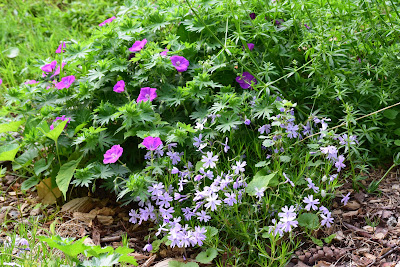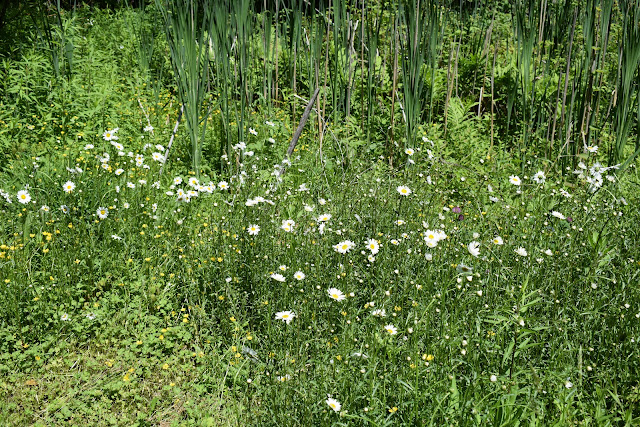Spring and early summer bring warm temperatures even in Vermont! And COLOR. Here we share the flowers in our Jericho, Vermont yard that displayed their beauty and unique attributes during June.
 |
| Spiderwort |
Our plantings are mostly individuals scattered about the yard so the best view requires one to walk around a bit to enjoy each flower's personality one at a time, up close and personal.
 |
| Josee Reblooming Lilac |
 |
| American Cranberry |
Some of the plants
around the yard (one acre)
Flowering plants
Astilbes
Azalea
Bee balm
Bleeding heart
Carolina Allspice bush
Clematis
Coreopsis
Crocus
Daffodils
Daisies
Dandelions
Daylilies
Echinacea
Euonymus
Foxglove (digitalis)
Heliotropium
Hibiscus
Hostas
Hyacinths
Hydrangeas
Iris – bearded and Siberian
Lamium
Ligularia
Lilacs
Lilies of the valley
Peonies
Phlox – tall and creeping
Purple Blazing Star
Rosa rugosa and other rose
varieties
Salvia (by well)
Sedum
Snowdrops
Spiderwort
Star of Bethlehem
Tiger lilies
Tulips
Vinca (also called myrtle and
periwinkle)
Violets
Wild asters
|
Trees
Birches
Blue spruce
Butternuts
Cedars
Elms
Hemlocks
Locust trees
Maples
Mountain Ash
Oaks
Fruit-bearing plants
Aronia (black chokeberry)
Blueberry
Cherries – bush and tree
Currants (black, red, white)
Elderberries
High-bush Cranberry
Gooseberry (4)
Honeyberries:Sweet, Tundra and Aurora.
Quince
Raspberries
Blackberries
Service Berry
Snowberries
Strawberries
|
Other plants that provide food for people and animals
Burdock
Cattails
Chives
Clover
Hazelnuts
Mint
Rhubarb
|
Neighbors and other Jericho residents have shared shoots or roots from some of their plants including rhubarb, lilacs, gooseberry, currants, hydrangea, and hosta.
Wild-growing flowers are as welcome as those we purchase with perhaps the exception of buttercups which seem to want to take over the whole yard for themselves.

No Mow slogans by Bernie:
- No Mow, Let it Grow.
- The grass is a configuration of the past, be hip, plant flowers and clover.
- Grass is always hungry, feed it clover instead of chemicals.
- Clover is lover with a C.
- Dandelions are hardy lions and their flowers are dandy.
- Mow no more, plant wildflowers and clover, and mowing will be over.
- Manicured lawns are sterile as the sands of the Sahara; Open an oasis -plant wildflowers.
- Grass is a pain in the butt. Plant flowers and clover. Pass on or reduce grass.
- And when and what you do mow, consider using an electric mower - Much quieter than gasoline-powered mowers. We have a large yard, and the battery holds a charge long enough to do the entire yard.

Our planet, our world, our eco-system our home-Earth is changing largely in reaction to us.
Perhaps we can help the pollinators (as well as birds) we so heavily depend on, as a small assist to an over trodden landscape - by planting native flowers, clover, even encouraging dandelions. While at the same time enjoying the pleasures of planting, caring for, and viewing flowers, butterflies, birds, many species of native bees, and various interesting insects.

no flower unadorned
from the smallest bloom
to the lightest sweet fragrance
all colors
all shapes
all times of bloom
remind us of nature's many personalities:
her beauty knows no bounds
is resilient
and helps us to be the same.
~Bernie
How to help all pollinators:
- Reduce and avoid lawn chemicals
- Add native plants to your garden
- Grow a bee lawn (clover makes a wonderful grass substitute or filler. Clover is a nitrogen fixer-fertilizes your lawn naturally)
- Vote with your wallet for organic and local food.
- Add healthy nesting houses
 |
| Native Bee House on a college campus in Everett WA |
Selecting plants for pollinators
The Farm Between
Vermont Native Plants
Native plant list for Maine, New Hampshire, Vermont.
Audubon native plant list and the birds they are likely to attract.
DELAWNING AMERICA
Enhancing Pollinator Populations in working Landscape for the complete slide presentation.
The Farm Between
Vermont Native Plants
Native plant list for Maine, New Hampshire, Vermont.
Audubon native plant list and the birds they are likely to attract.
DELAWNING AMERICA
Enhancing Pollinator Populations in working Landscape for the complete slide presentation.
Xerces.org (for invertebrate conservation) Includes Monarch Butterfly info.
MakewayforMonarchs.org Milkweed-butterfly alliance.
http://pollinator.org/ Protection and Promotion of Pollinators and their ecosystems.
Wild Flowers and Vermont's Food System by Taylor Ricketts, UVM
Getting Started with Wild Pollinators by Vermont Land Trust
Go Native. by Vermont Invasives
Gardening with Native Plants. Nature Conservancy
Vermont Atlas of Life Vermont Center of EcoStudies
Rearing Insect Pollinators. Seed Savers Exchange
Wildflowers Lady Bird Johnson Wildflower Center. Id native plants by state.
US Wildflowers Thumbnail list (with photos) and index.
Dancing Bee Gardens - Info on Honey. Raw honey, properties of honey, healing with...
Managing Alternative Pollinators (PDF handbook)
Louie Schwartzberg: The hidden beauty of pollination. The first half is a talk, then an excellent video of pollinators doing their thing.
VT Bumblebees are in trouble.
Mason Bees: (docile, excellent pollinator, and a native Vermont bee)
A VT keeper of Native Bees
Want to save the bees? Popular Science article
Nests for Native Bees. From www.xerces.org
Can you pick the bees out of this insect lineup? NY Times article
Solitary Mason Bees Growing a Greener World. (Video)
Mason bees Micro Documentary. Premies.com (Video)
Handbook for beekeepers. (170 pages)
Why bees are disappearing (TED Talk - video)
How to build a mason bee block Audubon - Bring on the Bees
How to construct a wood mason bee house. Penn State Extension
Crown Bees bee company. The website has lots of Mason bee info and items for sale. They even buy mason bees. And if you sign up for their newsletter you get periodic timely info. on caring for your mason bees and other mason bee tips.
The Little World. The video follows a female Mason Bee through her life as she raises a new generation.
Butterfly's
Save the Monarchs - What you can do to help US Fish & Wildlife Service
Permaculture
Life in Syntropy (Video)
Gardening and Soil Remediation
5 top secrets of successful gardeners Washington Post In-Depth Seed Starting
One teaspoonful of soil contains 4,000,000,000 bacteria, 144,000,000 actinomycetes, algae, and other microorganisms. Soil, unlike dirt, is a living, breathing ecosystem vital for sustaining all life on Earth.
The microflora in soils is the most abundant group of organisms on Earth. A teaspoon of soil contains up to a billion bacteria, several meters of fungal filaments, and thousands of protozoa and nematodes.
A nation that destroys its soil, destroys itself. ~Franklin D. Roosevelt5 top secrets of successful gardeners Washington Post In-Depth Seed Starting
Maine Organic Farmers and Gardeners Association (MOFGA) Agrihoods: Taking Farm-to-Table living Mainstream
Compost with only mulched leaves. Funny and instructional talk.
Improving Water Quality Through No-Till and Cover Crop Practices. ~Across the Fence video.
Building Soil. Vermont for Evolution
Growing w/o digging. How to grow an organic vegetable garden without digging. ~Huff Post
The One-Straw Revolution ~ Masanobu Fukuoka (YouTube Video)
Permaculture Forum and Wiki ~Permies website
Make a salad, not war with invaders. Dandelions ~Burlington Free Press
The Joy of Dirt. How getting dirty outdoors benefits kids. ~National Wildlife Foundation
Common Roots Celebrating the Soul and Soil of Community. South Burlington, Vermont.
Urban Micro Farm Urban permaculture 4,000 sq foot - 6,000 lbs food a year.
Urban Homestead website
Companion Planting (what plants do well together). Growing anything.com
Companion Planting Guide. (what plants do well together.) Uncle Luke's Feed Store.
Elmore Roots - Large plant and tree selection
WNRCD TREE SALE (Winooski Conservation District)
They take orders in Feb - pick up (bare root trees, berry plants, etc on a set day in April) Very reasonable prices.
No Mow
Why prairies matter and lawns don't
Redefining curb appeal. Homeowners are recognizing the value of replacing front lawns with native plants.
The Benefits of a clover lawn. Wild Birds Unlimited
Good Time to Eat Your Weedies (Burlington Free Press)
Five ways of making your lawn better.
Natural mosquito control
Making Mosquitoes Buzz Off -- Naturally
Remember, many weeds are friends of humankind. However, if you feel you need to remove some plants from a given area please use the least harmful elements to our environment in order to meet your objective.
Weed-Be-Gone Recipe
Ingredients
- 1 Gallon Vinegar
- 2 Cups Epson Salt
- 1/4 Cup Dish Soap
Preparation
- Mix and spray in the morning, after the dew has evaporated. Walk away. Go back after dinner and the weeds are gone.
Invasives
Natural World
1. Natural History Dictionary The Natural History Dictionary is a collaborative project based in Burlington, VT. Entries in this dictionary will help users figure out what the presence of a plant, fungus, animal, rock, natural phenomenon, or human artifact in an area indicates about that place in particular. ...our dictionary includes contextual information to help you understand why you find things where you find them and why you don’t where you don’t. Secondly, the dictionary will help you interpret the adaptive and ecological meaning of key features of plants, rocks, animals, etc
2. Crows Path:Wild Burlington Blog Connecting people with the natural world with direct engagement of the senses.
3. E-Butterfly. Report and share your butterfly observations, photographs, and collections to promote scientific discovery.
Our knowledge of the many life-forms on Earth - of animals, plants, fungi, protists, and bacteria - is scattered around the world in books, journals, databases, websites, specimen collections, and in the minds of people everywhere. Imagine what it would mean if this information could be gathered together and made available to everyone – anywhere – at a moment’s notice.
Our Vision: Global access to knowledge about life on Earth.
Our Mission: To increase awareness and understanding of living nature through an Encyclopedia of Life that gathers, generates, and shares knowledge in an open, freely accessible, and trusted digital resource.
5. Vermont Conservation stories.
5. Vermont Conservation stories.

























































No comments:
Post a Comment